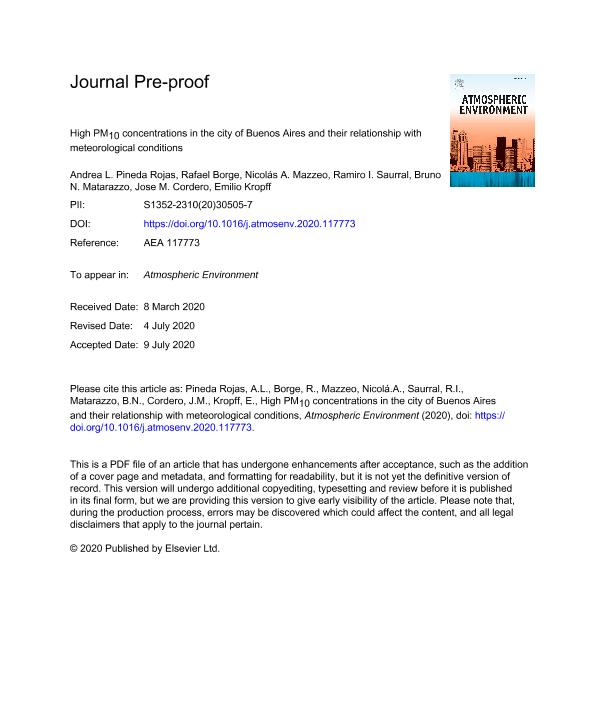Artículo
High PM10 concentrations in the city of Buenos Aires and their relationship with meteorological conditions
Pineda Rojas, Andrea Laura ; Borge, Rafael; Mazzeo, Nicolás A.; Saurral, Ramiro Ignacio
; Borge, Rafael; Mazzeo, Nicolás A.; Saurral, Ramiro Ignacio ; Matarazzo, Bruno Nicolas; Cordero, Jose M.; Kropff, Emilio
; Matarazzo, Bruno Nicolas; Cordero, Jose M.; Kropff, Emilio
 ; Borge, Rafael; Mazzeo, Nicolás A.; Saurral, Ramiro Ignacio
; Borge, Rafael; Mazzeo, Nicolás A.; Saurral, Ramiro Ignacio ; Matarazzo, Bruno Nicolas; Cordero, Jose M.; Kropff, Emilio
; Matarazzo, Bruno Nicolas; Cordero, Jose M.; Kropff, Emilio
Fecha de publicación:
11/2020
Editorial:
Pergamon-Elsevier Science Ltd
Revista:
Atmospheric Environment
ISSN:
1352-2310
Idioma:
Inglés
Tipo de recurso:
Artículo publicado
Clasificación temática:
Resumen
In this work, the first long-term (eight years) record of hourly concentrations of carbon monoxide (CO), nitrogen dioxide (NO2) and particulate matter with diameter less than 10 μm (PM10) from three sites in the city of Buenos Aires is analysed. Considering the short-term guidelines suggested by the WHO, the daily mean PM10 concentrations present a relatively large number of exceedances at the three sites. Different statistical techniques are combined to study the relationship between these relatively high PM10 concentrations and relevant surface meteorological variables. For all pollutants and sites, wind speed shows the largest differences between the lowest and highest concentration quartiles. To further explore its role on daily mean PM10 concentration, a k-means algorithm is applied, grouping days with similar surface 1h-wind sequences. Five wind sequence clusters are found, presenting distinctive air quality data features. Two clusters (1 and 2) show that PM10 exceedances occurring with winds entering the city from the river represent between 10 and 21% of total events at the three sites. The frequency of exceedance under these conditions decreases with the distance to the coast. For cluster 1, the hourly PM10 concentration profile and its associated daily wind sequence suggest an important contribution to exceedance events from the city's southernmost power plant. Two clusters (3 and 4), exhibiting continental winds, account for 49–59% of the exceedances and co-occur with relatively drier air conditions. The correlation between CO and PM10 for days belonging to cluster 3 supports the hypothesis of a potential remote or distributed source contribution with SW winds. For cluster 4, differences among sites in the number of events under NNW winds suggest an important contribution from the city's widest avenue to the PM10 levels at the most coastal site. A large contribution coming from urban sources is also indicated for these winds. Finally, cluster 5, exhibiting low wind speed sequences, accounts for 23–33% of the exceedances at the three sites. The average PM10 concentration increases with persistence of this cluster, which could be a driver for exceedances. These results contribute to show the importance of simple methods such as clustering analysis to obtain insights into air quality features such as exceedances and their potential drivers. They also suggest that further efforts in monitoring, modelling and emission estimates may help to better understand local, urban and regional source contributions to these events in the city of Buenos Aires.
Palabras clave:
AIR QUALITY DATA
,
BUENOS AIRES
,
EXCEEDANCE CONDITIONS
,
METEOROLOGICAL DATA
Archivos asociados
Licencia
Identificadores
Colecciones
Articulos(CIMA)
Articulos de CENTRO DE INVESTIGACIONES DEL MAR Y LA ATMOSFERA
Articulos de CENTRO DE INVESTIGACIONES DEL MAR Y LA ATMOSFERA
Articulos(IIBBA)
Articulos de INST.DE INVEST.BIOQUIMICAS DE BS.AS(I)
Articulos de INST.DE INVEST.BIOQUIMICAS DE BS.AS(I)
Citación
Pineda Rojas, Andrea Laura; Borge, Rafael; Mazzeo, Nicolás A.; Saurral, Ramiro Ignacio; Matarazzo, Bruno Nicolas; et al.; High PM10 concentrations in the city of Buenos Aires and their relationship with meteorological conditions; Pergamon-Elsevier Science Ltd; Atmospheric Environment; 241; 11-2020; 1-37; 117773
Compartir
Altmétricas



